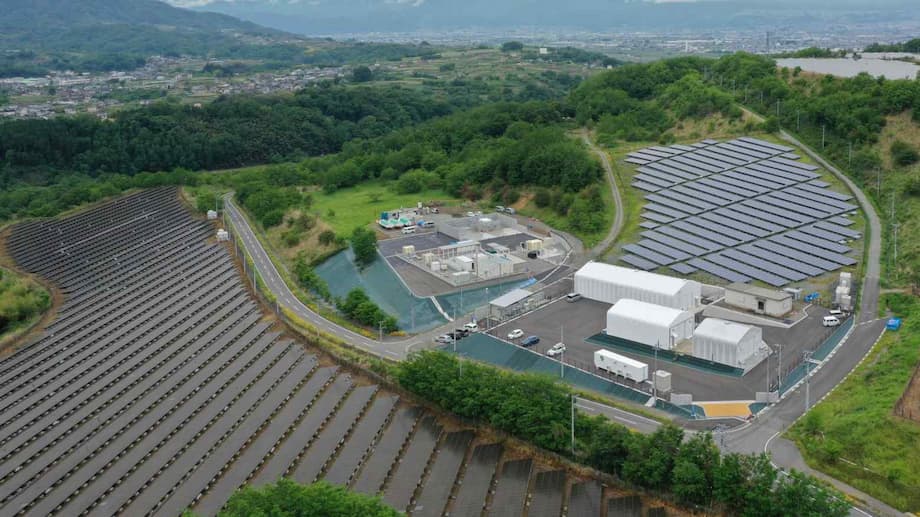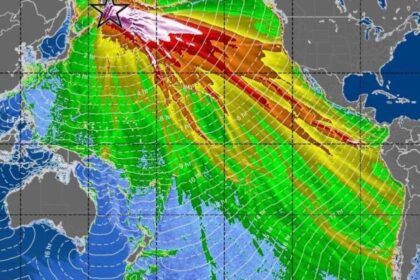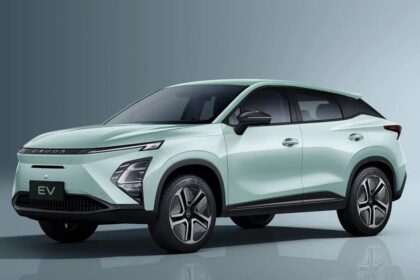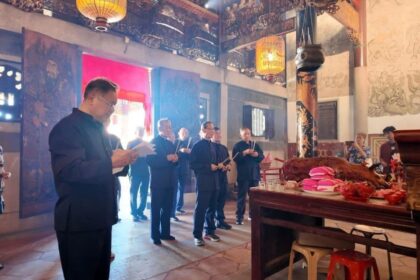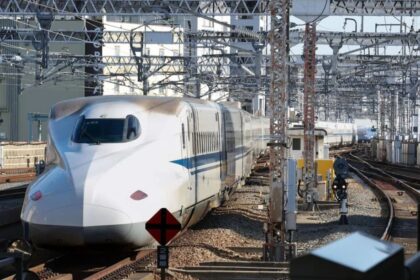Why Yamanashi is becoming Japan’s hydrogen laboratory
At the foot of Mt. Fuji, Yamanashi Prefecture has turned into a live testing ground for green hydrogen. Across Japan, hydrogen is gaining visibility as an alternative to fossil fuels. In Yamanashi, the trend is particularly clear. Companies from automobiles and engine makers to beverage, tire, and machine tool manufacturers are beginning to put the gas to work as part of their energy mix. The prefecture offers a rare combination of abundant renewable resources, research infrastructure, and active public private collaboration.
- Why Yamanashi is becoming Japan’s hydrogen laboratory
- What the Power to Gas system in Yamanashi actually does
- Inside Suntory’s 16 MW green hydrogen plan
- The JERA partnership and 24 hour carbon free power tests
- From solar to storage, how the Komekurayama hub evolved
- Who uses the hydrogen today
- Costs, benefits, and the constraints
- Will Yamanashi’s model scale beyond the prefecture
- What to Know
Yamanashi stands out for its high solar irradiation, a concentration of energy research assets, and policies that back projects from lab to factory floor. The Komekurayama area in Kofu hosts one of Japan’s most mature solar power clusters and a next generation energy system research village. Prefectural leaders have supported hydrogen pilot programs that connect daytime solar power with long duration storage and industrial heat, positioning the region to prove technology under real operating conditions and then scale it. The Yamanashi Hydrogen Energy Society (H2-YES), a joint venture linking the prefecture with companies, helps coordinate demonstrations and anchor customers.
What the Power to Gas system in Yamanashi actually does
Power to Gas, commonly abbreviated as P2G, converts electricity from renewable sources into hydrogen by splitting water into hydrogen and oxygen. The Yamanashi approach uses solid polymer water electrolysis. When solar output is strong, surplus power feeds the electrolyser. Hydrogen can then be compressed or liquefied and stored in tanks. Unlike electrons on the grid, stored hydrogen can be moved by truck, piped over short distances, or converted back into electricity and heat when needed. That turns intermittent solar power into a flexible energy resource for factories, warehouses, and local communities.
Backed by the Japanese government’s Green Innovation Fund and work commissioned by the national R&D agency NEDO, the Yamanashi Model P2G technology was co developed by Yamanashi Prefecture with Toray Industries, Tokyo Electric Power Company Holdings, and Takaoka Toko. A 16 megawatt installation based on this system is being built at Suntory’s Hakushu sites in the prefecture, planned to run on renewable electricity and local water so that the hydrogen produced emits no greenhouse gases when used. Project details are available from Suntory and the prefectural partners through this official overview.
Inside Suntory’s 16 MW green hydrogen plan
In September 2022, Suntory Holdings signed a basic agreement with Yamanashi Prefecture to decarbonize the Hakushu Distillery and the Minami Alps Hakushu Water Plant. The centerpiece is a 16 megawatt P2G facility that will electrolyze water using renewable electricity, producing green hydrogen on site. The company will use the gas as a clean heat source for plant operations and intends to share supply with the surrounding community.
Operations are slated to begin in 2025. In the first phase, hydrogen will run boilers for heat sterilization and support trial distillation at the Hakushu Distillery. From 2027, Suntory plans to operate across the full green hydrogen value chain in Japan, not just producing hydrogen but also distributing and selling it. A logistics partnership with Tomoe Shokai is set to enable deliveries within Yamanashi and to Tokyo. The company is studying additional uses at other facilities, such as the Chita Distillery in Aichi and the Takasago Plant in Hyogo.
The push comes after a planned hydrogen project tied to a distillery in the United Kingdom did not advance, prompting resources to shift toward domestic deployment. In Japan, the policy environment and local partnerships in Yamanashi provide a clear path to build, operate, and prove a full value chain from renewable power through to hydrogen fueled heat and power.
The JERA partnership and 24 hour carbon free power tests
On November 22, 2023, Yamanashi Prefecture signed a basic agreement with JERA, Japan’s largest power producer by generation share, to collaborate on a regional hydrogen value chain. JERA aims to combine renewable sources with zero emission thermal power using hydrogen and ammonia, and generates about 30 percent of the nation’s electricity. The partnership seeks to secure stable production and supply of carbon free electricity and hydrogen based fuels by integrating the prefecture’s P2G system with JERA’s fuel value chain and power assets. A public outline of the collaboration is available here: JERA partnership overview.
New hydrogen power generation facilities are planned for Mt. Komekura, where demonstration tests will supply electricity to local businesses. The target is proof of continuous carbon free power, achieved by blending solar generation with hydrogen fueled turbines or fuel cells when the sun is down or clouds pass. If it works at the prefectural scale, the approach could serve factories that need steady power at all hours.
From solar to storage, how the Komekurayama hub evolved
The prefecture’s solar build out at Komekurayama dates back to planning in the early 1990s, when the site was meant to attract companies. After the bubble economy burst, the land became a platform for large solar arrays in partnership with Tokyo Electric Power Company. That, in turn, set up the next phase. By 2021 the prefecture had launched a P2G initiative to convert solar surpluses into hydrogen using solid polymer water electrolysis. Early systems liquefied the hydrogen, stored it on site in specialized tanks, and moved it by trailer to where it was needed, such as shops using fuel cells for backup and peak power.
The next step is to expand beyond a single solar feed and draw certified renewable electricity from the standard grid mix, including hydro, wind, and geothermal sources. When hydrogen is produced on demand at the point of use, storage needs can shrink, transport costs fall, and the cost of green hydrogen can improve. Engineers in Yamanashi are also studying industrial applications that go beyond heat and power, such as using green hydrogen for semiconductor process cleaning in place of helium.
Who uses the hydrogen today
Suntory’s Hakushu sites are the anchor customer in the prefecture, with hydrogen planned for heat sterilization and to pilot direct fire whisky distillation. Beyond beverages, the tire sector has begun to experiment with on site hydrogen production for process heat and combined heat and power, pointing to a broader industrial market for the gas.
Transport is another area of momentum. The national government has backed fuel cells for heavy vehicles, with funding to automotive manufacturers to expand fuel cell production capacity. Several programs target hydrogen powered trucks that could refuel at depots during off peak hours, using green hydrogen produced when renewable power is plentiful. Those efforts align with Japan’s 2050 carbon neutrality commitment and the need to reduce dependence on imported fossil fuels.
Costs, benefits, and the constraints
Electrolysis is energy intensive. Producing one kilogram of hydrogen typically requires about 50 to 55 kilowatt hours of electricity, plus additional energy for compression or liquefaction. A 16 megawatt electrolyser running at full power for an entire day could make roughly 7 to 8 metric tons of hydrogen. Real output depends on the duty cycle, maintenance windows, and how much renewable electricity is available. Yamanashi’s strategy pairs on site solar, grid sourced renewables, and storage so the plant can run when power is clean and cheap.
Cost remains the central challenge. In Japan, wholesale power prices and grid charges can be high, which has constrained past hydrogen pilots. Using solar that might otherwise be curtailed, or shifting operations to times of low demand, can bring the cost per kilogram down. Electrolyser efficiency improvements and larger production volumes also help reduce the price over time.
Water supply and safety are two practical issues. Electrolysis consumes nearly nine liters of water for every kilogram of hydrogen produced, with additional water needed for purification. The Hakushu area is known for high quality groundwater used in beverages, which underscores the need for careful resource management and recycling. Hydrogen handling requires strict protocols for ventilation, leak detection, and training. Community concerns can arise around flammability, as seen in public debates over proposed projects abroad, so outreach and rigorous design standards are essential.
Will Yamanashi’s model scale beyond the prefecture
The framework being proven in Yamanashi is regional by design. It links local renewable resources, electrolysis, storage, and end users through a short supply chain. The next phase includes deliveries to Tokyo, which would connect a major demand center to green hydrogen produced in the mountains west of the capital. Success of the JERA demonstration of round the clock carbon free electricity would also give industry a template for reliable power without fossil fuels. Details about the collaboration are public through JERA’s project overview.
The work is already drawing international attention. Delegations from overseas have toured Yamanashi’s research hubs and industrial pilots, and plans are underway in some regions to establish centers of excellence for green hydrogen using lessons from Japan. Visits have featured technologies from fuel cell vehicles to research labs and production plants in the prefecture. That transfer of know how, along with national policy support, hints at how a local proving ground can influence projects far beyond its borders.
What to Know
- Yamanashi Prefecture is emerging as Japan’s proving ground for green hydrogen, linking abundant solar power with hydrogen production, storage, and industrial use.
- The Yamanashi Model Power to Gas system converts renewable electricity into hydrogen using solid polymer water electrolysis, turning intermittent solar into a flexible energy resource.
- Suntory and the prefecture are building a 16 megawatt electrolyser at the Hakushu Distillery and Minami Alps Hakushu Water Plant, with operations planned to start in 2025.
- From 2027, Suntory intends to operate across the full hydrogen value chain, including local distribution and sales in Yamanashi and Tokyo through a logistics tie up with Tomoe Shokai.
- JERA and Yamanashi signed a partnership in 2023 to build a regional hydrogen value chain and demonstrate round the clock carbon free power combining solar and hydrogen fueled generation.
- Komekurayama serves as the prefecture’s research and deployment hub, evolving from large solar arrays to P2G systems that produce, store, and transport hydrogen.
- Industrial users beyond beverages, including tire manufacturing, are piloting on site green hydrogen to cut emissions from process heat.
- Japan’s national programs support hydrogen for heavy vehicles, with funding to scale fuel cell production and ambitions for hydrogen fueled trucks.
- A 16 megawatt electrolyser could produce roughly 7 to 8 tons of hydrogen per day at full power, though real output depends on how it is operated.
- Key challenges include electricity and grid costs, water consumption, storage and logistics, and robust safety practices for hydrogen handling.
- Yamanashi’s approach is designed to be regional and replicable, with plans to supply Tokyo and growing interest from international delegations studying the model.


